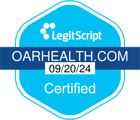Naltrexone Side Effects: What Are They And How Can They Be Managed?

The most common side effects of naltrexone are nausea, headache and dizziness.
Side effects typically subside with continued use, often within one to two weeks. So, many people taking naltrexone find that sticking it out while their bodies adjust to naltrexone is worth it in the long run to achieve their goals of drinking less or cutting out alcohol altogether.
However, side effects can be quite uncomfortable for some. So, experts recommend a few strategies to prevent or minimize them:
— Ramp up to a full dose: 50mg (typically one tablet) is considered a full dose of naltrexone. But you can ramp up to a full dose by taking a half dose for several days, then a split dose — meaning half in the morning and half at night, and then finally a full dose.
— Take a few days off: if you are experiencing side effects while taking a full dose, it is perfectly fine to take a few days off from the medication and then begin ramping up from a half dose or even less — such as a quarter dose or even a crumb of the tablet.
— Take with food: Taking naltrexone with a meal or snack can reduce side effects substantially.
— Use over-the-counter remedies: common medications can help manage side effects and make the adjustment to naltrexone more comfortable. For example, bismuth can help with nausea and pain relievers with headache.
As with all medications, naltrexone has side effects that affect some patients. There is no one-size-fits-all approach to managing side effects. The decision to continue or discontinue medication-assisted treatment is also highly individualized. Consulting with a healthcare professional, such as the medical providers on the Oar Health platform, can help patients make informed decisions.
About The Author
Oar is a telemedicine platform that makes science-backed, medication-assisted addiction treatment approachable and accessible for millions of consumers who feel excluded by the current treatment landscape and who may have a wide range of goals, from moderation to abstinence.
Related Articles
- How It Works
- Alcohol & Health
- Alcohol Misuse & Alcohol Use Disorder
- Strategies to Drink Less or Quit
- Treatment Options
- Medication-Assisted Treatment
- Recovery Stories
- Member Stories
- Moderation Stories
- Sobriety Stories
- ¹ Oar Health membership plans include access to the Oar Health platform, virtual consultations with a healthcare professional, and medication if prescribed by a healthcare provider. 3 month membership plan costs $297, equating to $99/mo.
- ² Self-reported by members after 6 months of Oar Health membership.
- ³ Verywell Health survey of Oar Health members, published March, 2023.
- ⁴ Prescription medication is available only if prescribed by a licensed clinician.
- ⁵ Compounded medications are prepared based on a prescription from a healthcare provider. They are not reviewed by the FDA for safety or efficacy.






